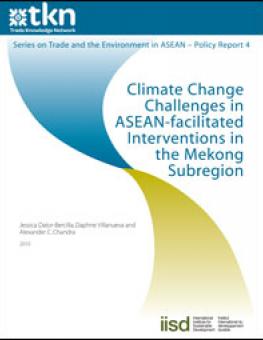
Climate Change Challenges in ASEAN-facilitated Interventions in the Mekong Subregion (Policy Report # 4)
By focusing on the Mekong subregion (comprising Cambodia, Lao PDR, Myanmar, Thailand and Vietnam) and Association of Southeast Asian Nations (ASEAN)-facilitated and/or -assisted international trade and investment arrangements, this policy report attempts to analyze the extent to which climate change impacts ASEAN-led trade and investment policies in the subregion.
Today, the economies of the subregion have grown impressively and many of them have started the process of moving from centrally planned to market-based systems and forging closer integration with external markets. Despite this, there is also increasing evidence that suggest that the vital agricultural and natural resources of the Mekong subregion are exposed to a wide range of climate-related risks. Because climate change has the capacity to impact on the development and survival of countries, climate change is viewed by some sectors as vital to the formulation of policy regimes, including those on trade. On the other hand, trade arrangements should also be examined closely if they are to avert the impacts of climate change and/or facilitate adaptation to and the mitigation of such impacts.
Key findings:
There is no doubt that the Mekong subregion is vulnerable to climate variability and change. Although national plans of actions and platforms have been created to respond to the challenge of climate-related hazards, many countries still regard trade liberalization as an important means to attain sustained economic growth.
Increasingly, the national plans of actions of countries in the subregion have provided for trade-related mechanisms aimed at addressing climate change challenges, such as the access to support through the Kyoto Protocol's Clean Development Mechanism, the establishment of market mechanisms to promote the use of alternative energy sources and so on. Despite this, it remains unclear whether such national plans of action can be attributed to ASEAN intervention.
A clearer mitigation action facilitated by ASEAN is the power generation projects in the Mekong subregion for the building of dams to supply hydroelectric power. Although this constitutes a low-carbon initiative and will provide a renewable energy source, the impact of these dams on natural resources will result in a loss of natural capital that cannot be substituted.
Some of the ASEAN-facilitated free trade agreements with its dialogue partners, such as the ASEAN-Australia-New Zealand Free Trade Agreement, have paved the way for mining industry development. While this may be considered as an alternative to climate-threatened agricultural production and other industries dependent on primary resources and therefore can be seen as an adaptation option, the cost in loss of natural capital is far too high for countries that have relied on natural resources for their major industries and as the backbone of their peoples' livelihoods.
Based on these findings, the policy recommendations of this policy report are as follows:
Climate change-related issues and/or concerns should be mainstreamed in ASEAN's institutional frameworks for economic cooperation.
Existing and proposed trading mechanisms and the resulting projects and programs should be subjected to climate risk assessments.
Climate strategies should be integrated into trade-related measures as possible instruments for mitigation efforts.
Alternative models of regional integration and economic polygons to address climate change concerns should be developed.
Additional downloads
You might also be interested in
Heatwaves to hit China once every 5 years as global extreme weather events multiply, study finds
Record-breaking heatwaves that have scorched North America, Europe and China are set to worsen in future unless the world stops burning fossil fuels, according to a study by the World Weather Attribution (WWA) academic initiative.
Britain Becomes First European Member of Trans-Pacific Trade Bloc
The United Kingdom becomes the first new member to join the Comprehensive and Progressive Agreement for Trans-Pacific Partnership (CPTPP) since it entered into force in 2018.
The CPTPP trade deal is a major threat to public health and warrants a health impact assessment
The UK government has joined one of the world’s largest free trade agreements, known as the Comprehensive and Progressive Agreement on Trans-Pacific Partnership (CPTPP). The CPTPP is not a new trade agreement waiting to be negotiated, but an already active one among 11 Pacific Rim countries (Australia, Brunei, Canada, Chile, Japan, Malaysia, Mexico, New Zealand, Peru, Singapore, and Vietnam). Joining the CPTPP commits the UK to several rules concerning trade in goods and services that have important implications for health. Although the US is not a member of the CPTPP, the agreement evolved from the Trans-Pacific Partnership, which initially included—and was shaped by—the US before President Trump withdrew the country from the deal in 2017. As such, many provisions, and even entire chapters, of the CPTPP are near carbon copies of other free trade deals negotiated by the US. But despite how much alarm was raised over the potential health effects of a free trade agreement with the US, there has been little discussion of the public health implications of the UK’s accession to this new deal.
Voluntary sustainability standards needed to improve South Asian cotton sector – report
A study by the International Institute for Sustainable Development (IISD) says that South Asia's cotton sector should accelerate its adoption of voluntary sustainability standards (VSS) to improve cotton sustainability.